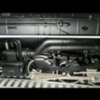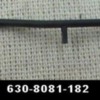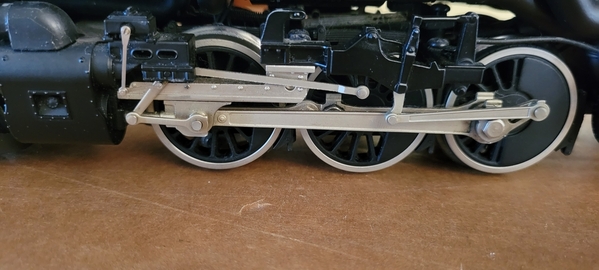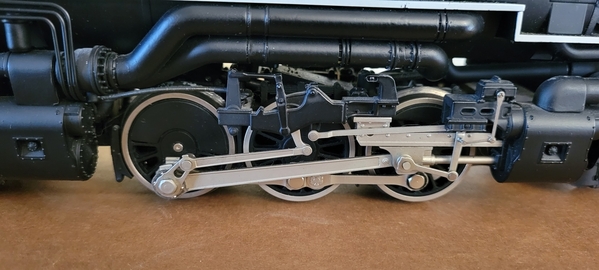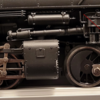My Son and I just opened up his brand new old stock JLC Allegheny last night. We lubricated all the wheel bearings etc. Upon running the locomotive the front drive shaft is hopping up and down a lot, and making quite a bit of noise. Also the elastic bands, on each side of the front drive section keep getting caught in the eccentric rods when the locomotive articulates on an 072 curve. Has anyone had these issues with their locomotive, and found a way to correct them. I am assuming the drives need to be pulled out and re-grease the worm gears. I am not sure how to remove the elastic bands on the front section. Also has anyone found a suitable replacement for the elastic bands. And I am also very afraid of breaking the Blow Down Pipe on the right rear drive to get it out. Any help would be greatly appreciated..
Replies sorted oldest to newest
I have this engine (and actually ran it for 3 hours last weekend) and have never had this issue. If you need to open it, there are 4 screws to do this (two in the back and I believe the others are under the lead truck . When you do that, only the top of the boiler comes off (there is a top and bottom of the shell), so when you take off the top of the boiler, the pipe will remain in place. When I have done this in the past, there were no issues with any of the under-boiler detail.
Just note, when you take it apart, be careful with the antennae leads as they are kinda fragile.
Allan, thank you. Do you have any issues with the elastic bands getting into the eccentric rods on the front drive ? I assume that they are just getting old and not very pliable. And are getting caught, because they do not stretch back properly. Does anyone know of a replacement material for them. The material is almost like a black elastic hair tie, but much thinner.
No issues with them - I got the engine as soon as it was in the catalog and it has been on my layout almost the whole time since and they are still pliable. Yes, the droop more, but they still work fine.
Really, the only issue I've had with the engine is that tender water lids have zinc-rot, so they are very brittle.
If you're talking the traction tires, once they come off, throw them away! Just run it without the tires until you figure out the other issues.
John I do not believe that the traction tires have any issue. When you run the locomotive the front drive shaft hops up and down a lot, and makes a lot of noise. It is brand new old stock, never run until last night.
Check the drive rods on the front truck to make sure they are aligned (match them up to the back drivers) before you take the engine apart. If out of alignment, it could cause the jump.
The drive rods and eccentric rods on the articulated locomotives are usually opposite front and back are they not ? For example if the right front drive eccentric rod faces 1:00. Then the rear drive eccentric rod would face 7:00. If you look at either side of the locomotive, the front and rear drives are not in the exact same position correct? Thank you everyone for your input and time.
The elastic "pipe" looks like it has been stretched. On my 1650 it is straight, not curved like yours. It looks like it represents the rod that connects the reversing mechanism to the front engine. If it is interfering with running in curves I would just remove it. Sometimes extra detail gets in the way of operation.
The front and rear engine drive rods don't have to be in any particular position. On a real articulated the front and rear engines are independent. Either can slip independently of the other so the drive rods could be in any position relative to the other engine. It makes no difference on a model either.
As far as the hopping of the front engine goes - make sure none of the brake shoes are rubbing on the drivers, especially the set with traction tires. If that all looks good you are going to have to remove the boiler top. Rotate the flywheel by hand slowly and see if you can see or feel any binding. You may have to remove the front engine to do any further checking. Remove the screw that secures the front engine to the rear engine on the underside of the engine. Then from the top remove the screw that holds the front engine to the boiler. Be careful to not lose the spring and washers and remember how they go back together. Remove the front engine so you can rotate the driveline to the front gear box by hand and look for binding.
My guess is since the "pipe" is stretched someone removed the front engine previously.
Ken
I can say for sure, the rubber tube indicated has nothing to do with the issues, it's strictly cosmetic.
A key issue is the position of the eccentric crank, if either of these are off, it'll really cause issues. Notice on both sets of drivers, the crank points in near the position of the axle on the wheel. The crank is indicated by the arrows.
************* Click on graphic to expand ***************
Also note that while the two driver sets aren't in sync, they can actually be in any relationship, including perfectly in sync, that will not affect the running at all. Every time you take one of these apart, they can go together in any of four different orientations. In addition, if you actually remove the worm from either gearbox for maintenance, they can then go together in any of dozens of orientations.
Attachments
The rubber tubes stretch on one side while its in a curve, and relaxes the other side. When the locomotive goes back to the straight track the rubber tube should stretch back. It does not and gets hit by the eccentric rods.
Sounds like you need new rubber tubes in that case.
When the locomotive is running, the front drive shaft hops up and down a lot, and makes noise. This is not normal operation. This locomotive was bought by my Son brand new from Trainz. He finished his layout, and this was the first time we could run it on 072 curves. The wheels, the tires and collector rollers did not show any signs of being used, when we took it out of the box. So if the front drive was removed by someone, and streached the rubber tubes it was still not run on the rails until last night. I was hoping that maybe some one had these same issues, and knew how to correct it. I will check the brakes to be sure that they are not rubbing on the tires and causing the front wheels to bind and make the drive shaft hop up and down. Thank you all so much for your advice.
That sounds like the rods are binding or their clearance is not as intended. Make sure all rods are not bent and when running slowly, not binding in any way.
John I believe the part is called a spring flex pipe, and of course its unavailable. Do you know where I could find something like that. It looks like a black stretchy hair tie, but much thinner.
Allan I will check the rods and the brakes to be sure there is no binding. As you know this is a difficult locomotive to handle. Maybe we pushed a brake into the traction tire on a wheel and didnt know it. Thanks Nick
I think I'd have to see it in person to have an idea of how to find something like that. I recently rounded up some rubber tubing to add the missing hoses to my MTH Propane Turbine set, but I knew what I was looking for.

Attachments
From what I remember, the front gearbox is not restrained so it may rotate about the axle a few degrees, especially without a load being pulled. If you ever look at some brass engines, you will sometimes see a strap on the gearbox to the frame to keep the floating gearbox from hunting under no-load running. This also keeps the input shaft from over working the universals. If the engine isn’t jerking and otherwise runs smoothly, I would check it out under a light to moderate load and see if the gearbox settles down with a little torque. A video might be helpful. Keep in mind the front shaft is sleeved and telescopes so it allows a bit more torsional freedom in this setup. I sold this engine off a few years ago so you may want to verify the gearbox arrangement. You should see the top of it change angle with direction and load assuming there isn’t some other issue.
You can see the front floating gearbox in Allan’s photos above, angled forward above the center drivers.




